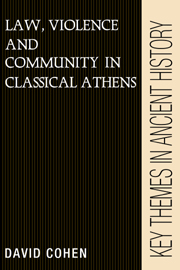Book contents
2 - Theorizing Athenian society: the problem of stability
Published online by Cambridge University Press: 06 January 2010
Summary
During the seven days that Eurymedon stayed there with his sixty ships the Corcyraeans continued to massacre those of their own citizens whom they considered to be their enemies … There was death in every shape and form. And, as usually happens in such situations, people went to every extreme and beyond it. There were fathers who killed their sons; men were dragged from the temples or butchered on the very altars; some were actually walled up in the temple of Dionysus and died there. So savage was the course of this civil war, and it seemed all the more so because it was one of the first … Later, of course, practically the whole of the Hellenic world was convulsed, with rival parties in every state.
(Thucydides 3.81–2)Stasis, the disintegration of a political community into rival warring factions, was the specter which haunted classical Greek political theory. Although Thucydides' principal focus was the war between states which convulsed the Greek world for the last thirty years of the fifth century, he also carefully analyzed the way in which the pressure of this external conflict intensified the tensions inherent within the polis and undermined the institutions responsible for maintaining social cohesion.
- Type
- Chapter
- Information
- Law, Violence, and Community in Classical Athens , pp. 25 - 33Publisher: Cambridge University PressPrint publication year: 1995

